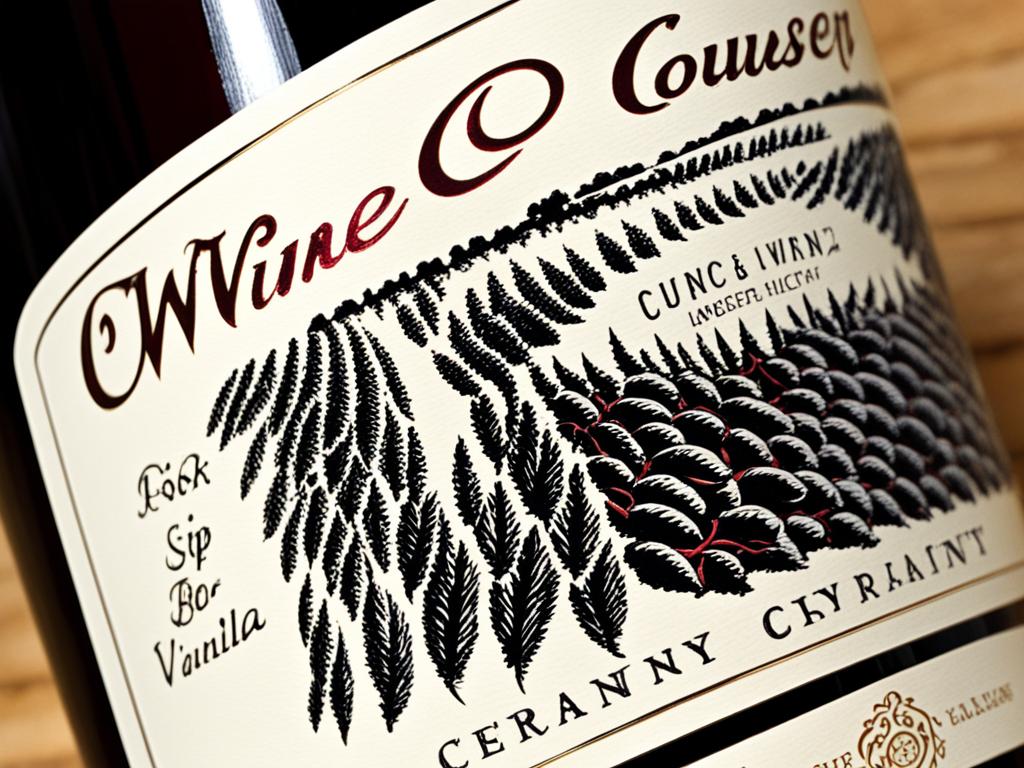Welcome to our guide on red dry wine! If you’re a wine enthusiast or simply curious about the world of red wines, you’ve come to the right place. In this section, we will take you on a journey through the various varietals and virtues of red dry wine, uncovering the secrets that make it so beloved by wine lovers around the globe.
Red dry wine is characterized by its rich and bold flavors, often accompanied by a slightly dry finish. It is made from an array of red grape varietals, each contributing its unique characteristics to the final product. From the robust Cabernet Sauvignon to the elegant Pinot Noir, there is a red dry wine to suit every palate and occasion.
Produced in renowned regions across the world, red dry wine showcases the influence of terroir, climate, and winemaking techniques. Whether it’s the old-world charm of Bordeaux in France or the new-world exuberance of Napa Valley in California, each region adds its distinct touch to the wine, creating an unparalleled tasting experience.
But red dry wine isn’t just about flavor and craftsmanship. It also offers a number of health benefits when consumed in moderation. Studies have suggested that moderate red wine consumption may contribute to heart health and overall well-being, thanks to its antioxidant properties and potential positive effects on blood pressure.
So, whether you’re a wine connoisseur looking to expand your knowledge or a casual wine drinker wanting to learn more about red dry wine, this guide is here to provide you with all the information you need. From understanding the characteristics of dry red wines to exploring the key regions for production, we’ll guide you through the world of red dry wine step by step.
Stay tuned as we dive deeper into the intricacies of dry red wines, uncovering the art of tasting, aging potential, and perfect food pairings. Are you ready to raise a glass and embark on an exciting wine adventure? Let’s get started!
Key Takeaways:
- Red dry wine offers a range of bold flavors and a slightly dry finish.
- There are various red grape varietals that contribute to the unique characteristics of red wines.
- Renowned regions around the world produce exceptional red dry wines.
- Red wine, when consumed in moderation, may offer health benefits.
- Stay tuned as we delve into the art of tasting, aging potential, and food pairings for red dry wines.
Understanding Dry Red Wines
To fully appreciate red dry wine, it’s important to understand its characteristics and how it differs from other types of wine. Dry red wines have unique qualities that set them apart and make them a favorite among wine enthusiasts. Let’s dive into the world of dry red wines and explore what makes them so special.
Tannin Levels and Fruit Flavors
One of the defining features of dry red wines is their tannin levels. Tannins are natural compounds found in grape skins, seeds, and stems, which give red wines their characteristic dryness and astringency. Understanding Dry Red Wines, you’ll notice that some red wines have higher tannin levels than others. This influences the texture and mouthfeel of the wine, creating a sense of depth and structure.
In addition to tannins, dry red wines also boast a wide array of fruit flavors. From rich blackberry and black cherry in Cabernet Sauvignon to bright raspberry and red currant in Pinot Noir, each varietal offers its unique fruit profile. These flavors add complexity and depth to the wine, making every sip a sensory delight.
Preferred Serving Temperatures
Serving temperature plays a crucial role in unlocking the full potential of dry red wines. Understanding Dry Red Wines means knowing the optimal temperature at which to serve them. Generally, full-bodied and bold reds like Cabernet Sauvignon and Syrah are best served between 60°F and 65°F (15°C and 18°C). This allows the complex flavors to shine without overpowering the palate. Lighter red wines such as Pinot Noir and Beaujolais are typically served slightly cooler, around 55°F (13°C), to preserve their delicate aromas and balance.
“The unique characteristics of dry red wines, from their tannin levels and fruit flavors to their preferred serving temperatures, make them a fascinating and diverse category of wines to explore.” – Wine Enthusiast
The Significance of Dryness
The term “dry” in dry red wine refers to the absence of residual sugar. Unlike sweet or off-dry wines, dry red wines have minimal sugar content, allowing the natural flavors of the grapes to shine through without any perceived sweetness. This dryness enhances the overall taste profile, contributing to a more balanced and nuanced wine experience.
Now that you have a better understanding of dry red wines, we can move on to exploring the key regions where these wines are produced. Join us in the next section as we embark on a journey through the world’s finest red wine regions.
Key Regions for Red Dry Wine Production
When it comes to producing exceptional red dry wine, not all regions are equal. Certain areas in the world have gained recognition for their expertise in red wine production. In this section, we will explore some of the key regions that are renowned for their contribution to the world of red dry wine.
Bordeaux, France
The vineyards of Bordeaux, France, have long been celebrated as one of the most iconic and respected wine regions in the world. Bordeaux is known for its classic red wine blends, primarily made from Cabernet Sauvignon, Merlot, and Cabernet Franc grape varietals. The unique climate, terroir, and winemaking traditions of Bordeaux combine to create red dry wines that are elegant, complex, and age-worthy.
Napa Valley, California
Nestled in the heart of California, Napa Valley has emerged as a prominent region for red wine production. The warm Mediterranean climate, fertile soil, and diverse microclimates make it an ideal location for growing red grape varietals such as Cabernet Sauvignon and Merlot. Napa Valley’s commitment to quality, innovation, and sustainable practices has contributed to the production of exceptional red dry wines that showcase rich fruit flavors and refined tannins.
Tuscany, Italy
Tuscany, Italy, is renowned for producing some of the world’s most beloved red dry wines. The region’s most famous red wine, Chianti, is made primarily from Sangiovese grapes and offers a delightful balance of acidity, fruitiness, and earthy characteristics. Other notable red wine regions in Tuscany include Brunello di Montalcino and Vino Nobile di Montepulciano, both known for their elegance, longevity, and depth of flavors.
“The terroir of a region plays a crucial role in the quality and characteristics of red dry wines.”
These regions are just a glimpse into the vast world of red dry wine production. Each region has its own unique combination of climate, soil, grape varietals, and winemaking traditions that contribute to the final product. Exploring the red dry wines from different regions allows you to experience the diversity and craftsmanship of this beloved wine style.
Now that we have explored the key regions for red dry wine production, let’s continue our journey by understanding how to taste and describe the unique qualities of these wines in the next section.
Tasting and Describing Dry Red Wines
Tasting and describing dry red wines is an art that can be mastered through knowledge and practice. In this section, we will provide you with valuable tips and techniques to evaluate and appreciate the complexities of dry red wines. Whether you are new to wine tasting or a seasoned enthusiast, our guidance will help you develop your palate and enhance your sensory experience.
Understanding Color and Clarity
The first step in tasting red wines is to observe their color and clarity. Hold your glass against a white background and examine the hue, intensity, and transparency of the wine. The color can provide insights into the grape variety and age of the wine. Younger red wines tend to have a vibrant, purplish hue, while older wines may exhibit brick or garnet tones.
Identifying Aromas and Flavors
Next, take a gentle swirl of the wine to release its aromas. Bring the glass to your nose and inhale deeply, focusing on the scents that arise. Dry red wines often exhibit notes of dark fruits like blackberries and cherries, alongside earthy undertones and hints of spices or oak. Take your time to identify these aromas and make mental notes, as they contribute to the overall flavor profile of the wine.
“The aroma of a red wine can transport you to a specific time and place, evoking memories and sensations that enhance the tasting experience.”
Assessing Body and Tannins
The body of a wine refers to its weight and texture on the palate. Dry red wines can range from light-bodied, with delicate flavors and smooth tannins, to full-bodied, with rich, robust characteristics and more pronounced tannins. Tannins are compounds found in grape skins and seeds that create a drying, sometimes astringent sensation on the tongue. They contribute to the structure and aging potential of red wines.
Pairing with Food
Finally, consider the food pairings that complement the flavors of dry red wines. The boldness and structure of red wines make them a perfect match for hearty dishes such as grilled meats, aged cheeses, and rich sauces. Experiment with different flavor profiles to find the perfect pairing and enhance your overall dining experience.
By following these guidelines and practicing regularly, you will soon become proficient in tasting and describing dry red wines. Remember, the journey of wine appreciation is a lifelong pursuit, filled with delightful discoveries and endless possibilities.
Aging Potential of Red Dry Wines
One of the fascinating aspects of red dry wine is its aging potential. As red wines age, they develop complex flavors and aromas that enhance the overall drinking experience. Understanding the factors that contribute to a wine’s aging ability can help you appreciate and choose wines that are best suited for longer cellaring.
There are several key factors that influence the aging potential of red dry wines:
- Grape Variety: Certain grape varieties have a natural predisposition for aging. For example, Cabernet Sauvignon and Nebbiolo are known for their longevity.
- Structure and Tannins: Wines with high tannin levels and robust structure have the potential to age well. The tannins act as preservatives, providing stability and allowing the wine to develop over time.
- Acidity: Wines with balanced acidity tend to age gracefully. The acidity helps to maintain freshness and prevents the wine from deteriorating.
- Aging Methods: Some wines are aged in oak barrels, which imparts additional flavors and textures to the wine. Others are aged in the bottle, allowing them to slowly mature and develop complexity.
When it comes to aging methods, oak barrel aging and bottle aging each contribute unique characteristics to the wine. Oak barrels add subtle notes of vanilla, spice, and toast, while bottle aging allows the wine to develop tertiary aromas such as leather, tobacco, and earthy nuances.
“The aging potential of red dry wines is a testament to the craftsmanship and artistry of winemaking. It’s a fascinating journey to witness a young, vibrant wine transform into a mature and complex masterpiece.” – Renowned Sommelier
To showcase the exceptional aging potential of red dry wines, here are a few renowned examples:
| Wine | Region | Aging Potential |
|---|---|---|
| Château Margaux | Bordeaux, France | 20-30+ years |
| Screaming Eagle | Napa Valley, California | 15-20 years |
| Penfolds Grange | Barossa Valley, Australia | 20-30+ years |
These wines have gained recognition for their exceptional aging potential, with some vintages continuing to evolve and improve for decades. As with any aged wine, it’s essential to store them properly in a cool, dark environment to ensure optimal aging conditions.
Exploring the aging potential of red dry wines allows wine enthusiasts to embark on a sensory journey, witnessing the remarkable transformation that occurs over time. Whether you choose to age wines in your own cellar or enjoy them at their peak, the aging potential of red dry wines showcases the depth and complexity that makes them truly special.
Food Pairings with Dry Red Wines
Pairing the right food with a dry red wine can elevate the dining experience to new heights. The flavors and structure of dry red wines can complement a wide variety of dishes, enhancing both the wine and the food. Whether you’re enjoying a rich Cabernet Sauvignon with a juicy steak or a velvety Pinot Noir with a delicate salmon dish, the art of pairing dry red wines with various cuisines can truly enhance the flavors and create a harmonious dining experience.
When it comes to pairing food with dry red wines, consider the characteristics of the wine and the flavors of the dish. The intensity, body, acidity, and tannins of the wine should be taken into account, as well as the flavors and textures of the food. Here are some popular food pairings to enhance your enjoyment of dry red wines:
1. Cabernet Sauvignon
One of the most popular and full-bodied dry red wines, Cabernet Sauvignon pairs well with grilled meats, hearty stews, and aged cheeses. The wine’s bold flavors and firm tannins complement the richness of dishes like prime rib, lamb chops, and beef tenderloin. The high acidity also cuts through the fat, creating a balanced and satisfying pairing.
2. Pinot Noir
With its smooth and elegant profile, Pinot Noir is a versatile wine that pairs well with a range of dishes. It pairs beautifully with roasted poultry, such as chicken or turkey, as well as grilled salmon or mushroom-based dishes. The wine’s bright acidity and red fruit flavors add complexity to the overall dining experience.
3. Merlot
Merlot, known for its soft and velvety texture, is a great choice for pairing with red meats and rich sauces. It complements dishes like braised short ribs, pasta with meat sauce, and roasted duck. The wine’s moderate tannins and ripe fruit flavors provide a smooth and harmonious balance to the savory flavors of the food.
4. Syrah/Shiraz
Syrah, also known as Shiraz, is a robust and spicy wine that pairs well with bold flavors. It is an excellent match for grilled meats, barbecued dishes, and spicy sausages. The wine’s peppery notes and dark fruit flavors enhance the smoky and spicy components of the food, creating a dynamic and flavorful pairing.
5. Malbec
Originating from Argentina, Malbec is a full-bodied and fruit-forward wine that pairs well with grilled meats and hearty dishes. It harmonizes beautifully with dishes like steak, lamb, and beef empanadas. The wine’s ripe black fruit flavors and velvety tannins create a luxurious and satisfying pairing.
“The key to successful food pairings with dry red wines lies in finding balance and harmony between the flavors and textures of the wine and the food. Experiment with different combinations to discover your own favorite pairings.”
Remember, these are just general guidelines, and personal taste preferences can vary. It’s always best to trust your own palate and experiment with different pairings to find what works for you. The most important thing is to enjoy the experience and savor the flavors of both the wine and the food.
| Dry Red Wine | Food Pairings |
|---|---|
| Cabernet Sauvignon | Grilled meats, hearty stews, aged cheeses |
| Pinot Noir | Roasted poultry, grilled salmon, mushroom-based dishes |
| Merlot | Red meats, rich sauces, roasted duck |
| Syrah/Shiraz | Grilled meats, barbecued dishes, spicy sausages |
| Malbec | Steak, lamb, beef empanadas |
Conclusion
As we come to the end of our exploration of red dry wine, we cannot overlook the potential health benefits associated with moderate consumption. Red wine, when enjoyed in moderation, can have positive effects on heart health and overall well-being.
Studies have shown that red wine contains antioxidants, such as resveratrol, which may help reduce the risk of heart disease by improving cholesterol levels and promoting healthy blood pressure. Additionally, the polyphenols found in red wine have been linked to lower inflammation and improved blood vessel function.
However, it’s important to note that moderation is key. Excessive alcohol consumption can have adverse health effects and should be avoided. For men, moderation means up to two standard glasses of red wine per day, while for women, it’s recommended to stick to one glass.
We hope this comprehensive guide has deepened your understanding and appreciation for red dry wine. By exploring its varieties and virtues, you can unlock the joy of experiencing the complex flavors and aromas that red wine has to offer. So, raise your glass, savor each sip, and toast to the health aspects of red wine!







